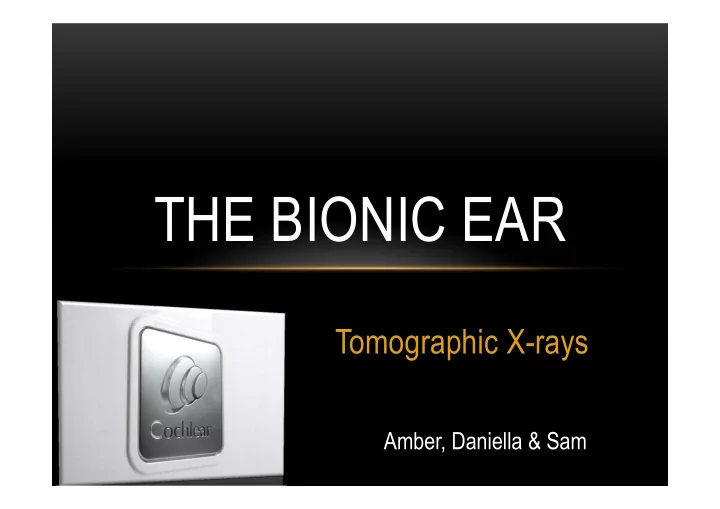

THE BIONIC EAR Tomographic X-rays Amber, Daniella & Sam
WHY WE CHOSE THIS PROGRAM?
WHAT WE DID DURING WORK EXPERIENCE Took a series of x-rays (of rat cochlea) and made 3D reconstruction • Went to the Australian Synchrotron – tour & experiment (with lasers) • Melbourne University – Bionic Eye institute (tour of labs and presentation) • Research about Cochlear implant – how tomographic results helps research • in that area Presentation & Article •
HOW HEARING WORKS • Sound passes through the outer ear and onto the ear drum.
HOW HEARING WORKS • Sound passes through the outer ear and onto the ear drum. • The sound/vibration is amplified by the bones in the middle ear.
HOW HEARING WORKS • Sound passes through the outer ear and onto the ear drum. • The sound/vibration is amplified by the bones in the middle ear. • The liquid inside the inner ear because of the vibrations moves over sensory cells.
HOW HEARING WORKS • Sound passes through the outer ear and onto the ear drum. • The sound/vibration is amplified by the bones in the middle ear. • The liquid inside the inner ear because of the vibrations moves over sensory cells. • These sensory cells send electrical impulses to the brain via the auditory nerve .
THE EAR
DEAFNESS • Defined as a loss of hearing. • Related to the volume and pitch or frequency of sound that a person can perceive.
DEAFNESS • More than one form of deafness • Conductive Hearing loss • Neural hearing loss • Mixed hearing loss • Noise Induced Hearing loss
COCHLEA • The auditory portion of the inner ear.
COCHLEA • The auditory portion of the inner ear. • Made up of two main parts, Organ of Corti and the cochlear duct.
COCHLEA • The auditory portion of the inner ear. • Made up of two main parts, Organ of Corti and the cochlear duct. • Filled with liquid which flows over tiny hairs to produce electrical signals which are sent to the brain.
THE COCHLEAR IMPLANT • Invented by Graeme Clark in 1978 • Helps people with impaired hearing • Provide hearing to those that have damage to the sensory hairs in their cochlea • Sounds such as foot steps, and music are heard differently as the implant only picks up a limited amount of frequencies. • Newer devices allow for a wider range of frequencies to be picked up.
MICROPHONE • Microphone: Used to pick up sound from its surroundings.
SPEECH PROCESSOR • Speed Processor: Translates the auditory input into electrical impulses.
TRANSMITTER • Transmitter: Transmits the electrical impulses to the electrodes in the cochlea.
ELECTRODE ARRAY • Electrode Array: Picks up the electrical signals and sends them to the brain via the auditory nerve.
WHY A COCHLEAR IMPLANT? • Rather than pick up sound and amplify it the cochlear implant picks up the signal and transmits it directly to the cochlear, bypassing dysfunctional areas of the ear.
COCHLEAR IMPLANT VS. HEARING AID
BENEFITS
X-RAYS • Electromagnetic radiation of short wave lengths. • Produced when electrons collide with a solid target → lab based source.
SYNCHROTRON • Produces x-rays from high speed electrons.
TOMOGRAPHY • -Uses X-ray images taken from different angles • -the 2D images are then used to produce a 3D reconstruction of the sample • -the model can be cut and the inside of the sample can be viewed
RESULTS X-RAY PROJECTION -45 ° 0 ° -90 ° 90 ° 45 °
3D TOMOGRAPHIC RECONSTRUCTION
COCHLEA – WITHOUT IMPLANT
COCHLEA – WITH IMPLANT
THE COCHLE Questions?
Recommend
More recommend